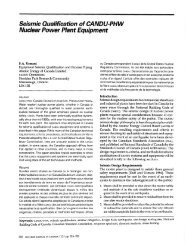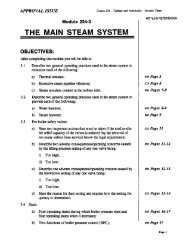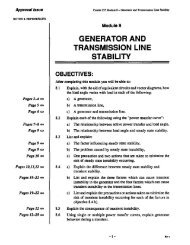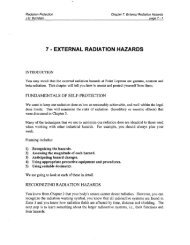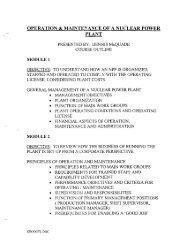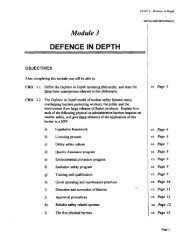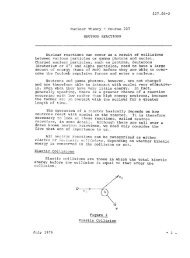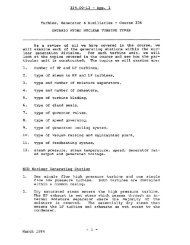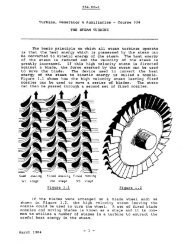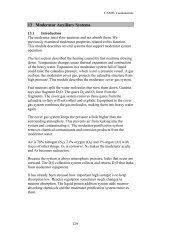Reactor Control Systems of Qinshan Phase III CANDU ... - canteach
Reactor Control Systems of Qinshan Phase III CANDU ... - canteach
Reactor Control Systems of Qinshan Phase III CANDU ... - canteach
Create successful ePaper yourself
Turn your PDF publications into a flip-book with our unique Google optimized e-Paper software.
establishing and maintaining the plant in a safe shutdown state have been provided in the<br />
SCA. This contains the controls <strong>of</strong> Shutdown System 2, Containment System and<br />
portions <strong>of</strong> the Emergency Core Cooling functions, Post Accident Monitoring (PAM)<br />
instrumentation and information as required for expected use <strong>of</strong> the SCA, Emergency<br />
Water Supply controls and Emergency Power Supply as provided by the emergency<br />
diesel generators.<br />
Digital <strong>Systems</strong><br />
Overall, <strong>CANDU</strong> 6 plant control is highly automated, so that the operator's role is to<br />
provide top level commands and to monitor and supervise rather than carry out manual<br />
control. This control is augmented by fully automated safety system action which affords<br />
a long operator grace period for decision making in the event <strong>of</strong> any upsets or accidents.<br />
The QCNP control system consists <strong>of</strong> two independent digital computer control systems<br />
DCCX and DCCY with a combined reliability <strong>of</strong> 99.99%.<br />
The DCC computers also provide process monitoring and control through the computer<br />
interface. A separate digital computer system, the Plant Display System (PDS), drives<br />
supplementary plant process monitoring displays and performs alarm annunciation. This<br />
system is designed to support higher levels <strong>of</strong> information processing in support <strong>of</strong><br />
operator diagnostic and decision-making tasks and improve the operators awareness <strong>of</strong><br />
the state <strong>of</strong> the plant at all times.<br />
Safety <strong>Systems</strong> (<strong>Reactor</strong> Protection)<br />
Automatic control and safety system functions give the operator a period <strong>of</strong> 2 hours<br />
before safety critical response is needed for single initiating events. Even for hypothetical<br />
"dual failure" events, where an initiating event is assumed coincident with a safety system<br />
failure, a grace period <strong>of</strong> 15 minutes is built-in to design.<br />
Plant Computer <strong>Control</strong><br />
The plant control computers control all major functions including the reactor, the<br />
moderator, the heat transport, and the turbine systems. Continuous direct digital control<br />
<strong>of</strong> the reactor by manipulation <strong>of</strong> reactivity control devices <strong>of</strong>fer optimum reactor<br />
performance at all times. In the event <strong>of</strong> detected abnormal conditions, direct digital<br />
control <strong>of</strong> reactor power using setback and stepback power reduction algorithms avoid<br />
tripping <strong>of</strong> the system by special safety shutdown systems. This permits quick<br />
correction <strong>of</strong> process abnormalities and a return to power production. Process control<br />
programs <strong>of</strong> the DCCs perform direct digital control <strong>of</strong> steam pressure, moderator<br />
temperature, steam generator level, heat transport system, turbine speed and load and<br />
fueling machines. The major processes are all under full computer control from all states<br />
CJNPE_paper990401<br />
11/21/05<br />
12




